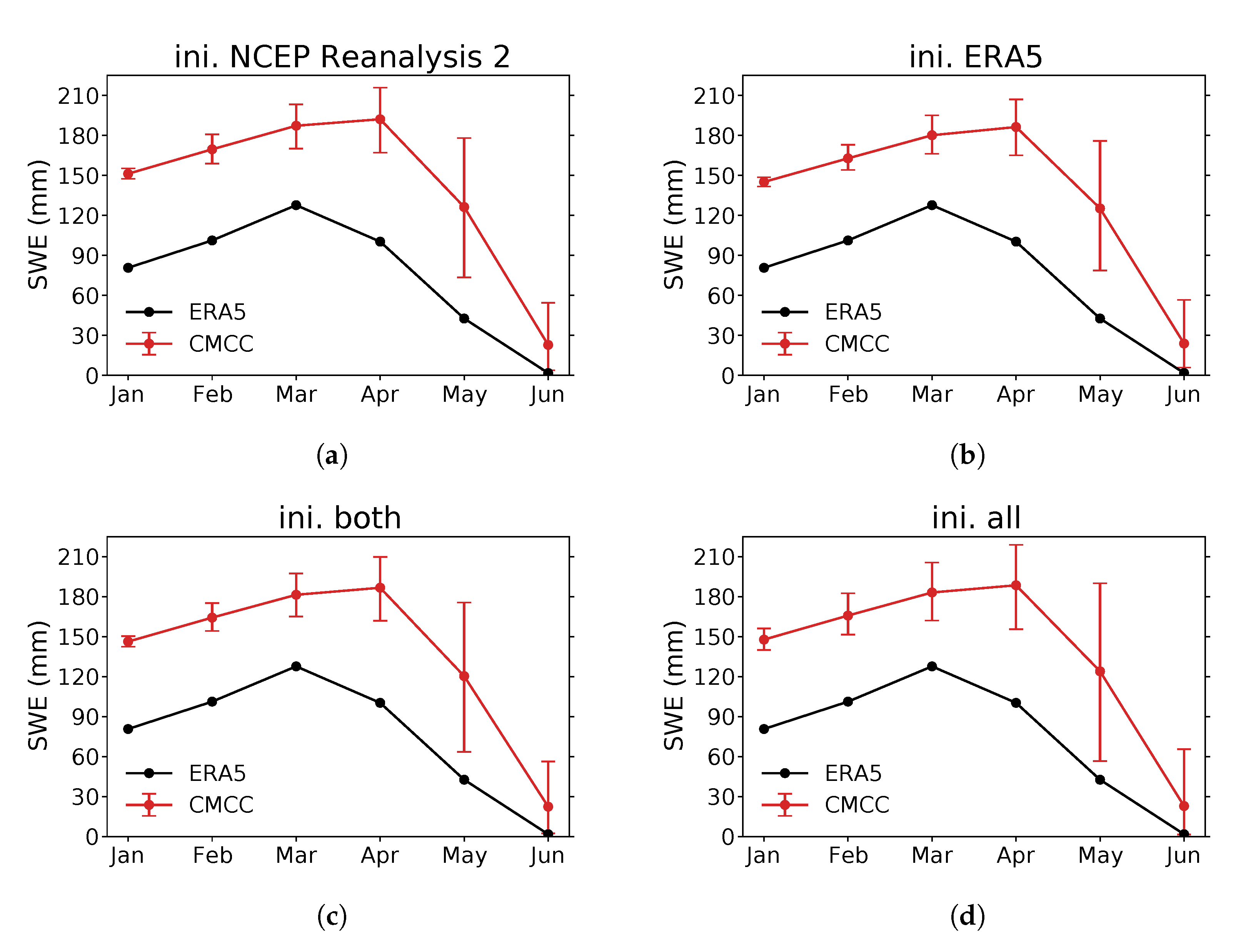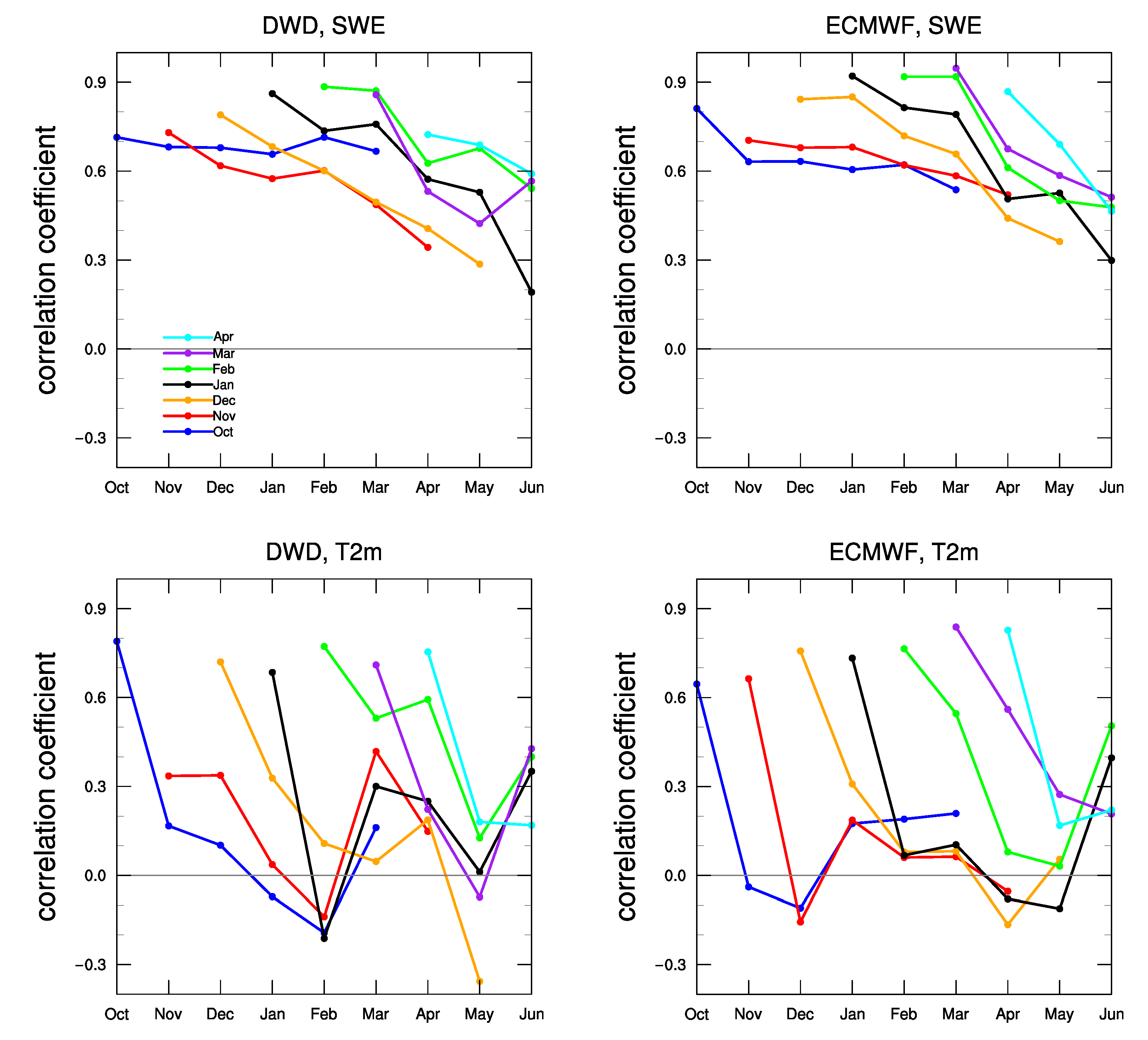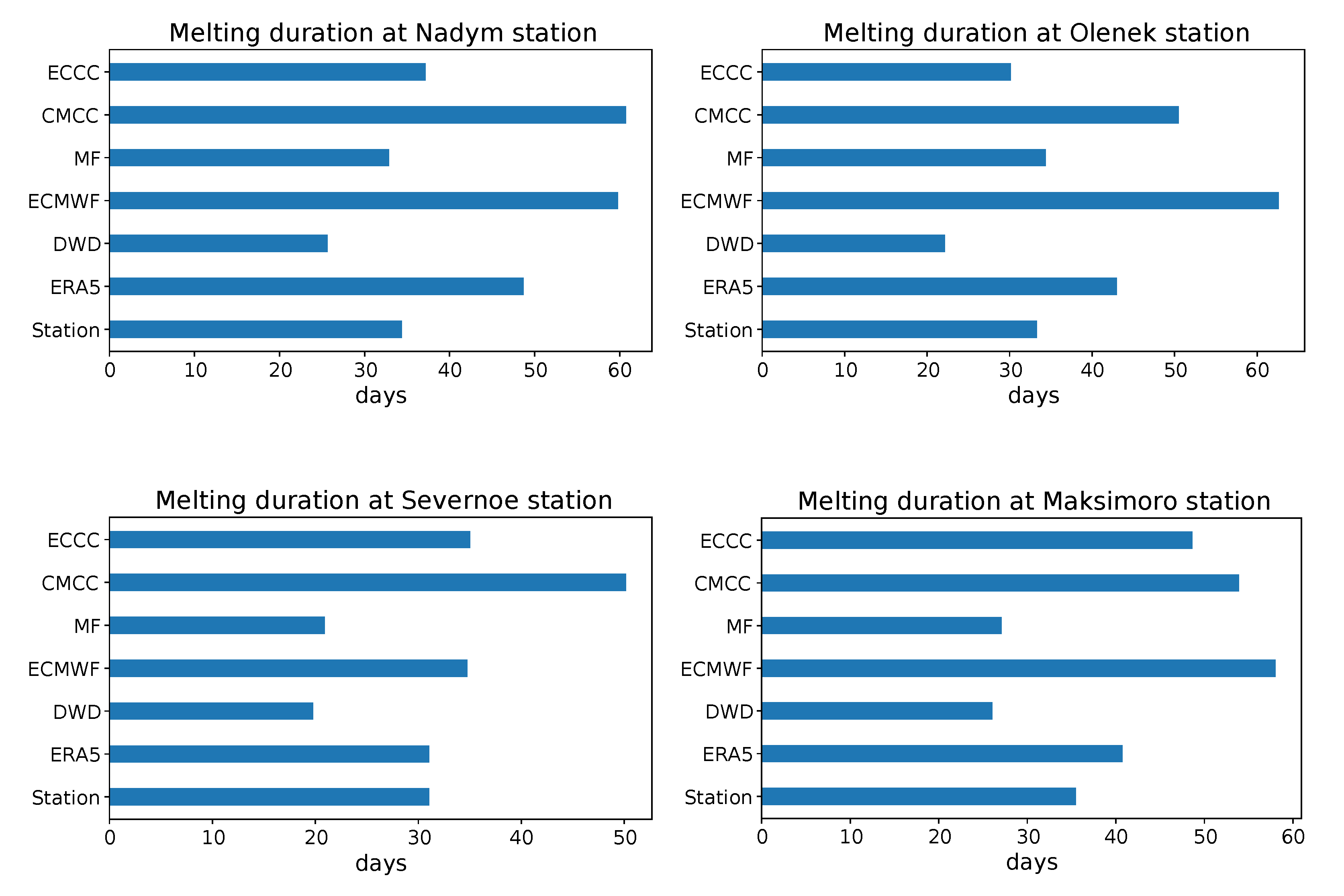Snow Representation over Siberia in Operational Seasonal Forecasting Systems
Abstract
:1. Introduction
2. Data and Methods
2.1. Seasonal Forecasting Systems
2.2. Reference Data
2.3. Bias, Correlation, and Melting Phase Evaluation
3. Results and Discussion
3.1. Initial Biases
3.2. Snow Parameterization
4. Summary and Conclusions
Author Contributions
Funding
Institutional Review Board Statement
Informed Consent Statement
Data Availability Statement
Acknowledgments
Conflicts of Interest
References
- Diro, G.T.; Lin, H. Subseasonal Forecast Skill of Snow Water Equivalent and Its Link with Temperature in Selected SubX Models. Weather Forecast. 2020, 35, 273–284. [Google Scholar] [CrossRef]
- Lin, H.; Wu, Z. Contribution of the Autumn Tibetan Plateau Snow Cover to Seasonal Prediction of North American Winter Temperature. J. Clim. 2011, 24, 2801–2813. [Google Scholar] [CrossRef]
- Sobolowski, S.; Gong, G.; Ting, M. Modeled Climate State and Dynamic Responses to Anomalous North American Snow Cover. J. Clim. 2010, 23, 785–799. [Google Scholar] [CrossRef]
- Ruggieri, P.; Benassi, M.; Materia, S.; Peano, D.; Ardilouze, C.; Batté, L.; Gualdi, S. On the role of Eurasian autumn snow cover in dynamical seasonal predictions. Clim. Dyn. 2022, 58, 2031–2045. [Google Scholar] [CrossRef]
- Henderson, G.; Peings, Y.; Furtado, J.C.; Kushner, P.J. Snow–atmosphere coupling in the Northern Hemisphere. Nat. Clim. Chang. 2018, 8, 954–963. [Google Scholar] [CrossRef]
- Jeong, J.H.; Linderholm, H.W.; Woo, S.H.; Folland, C.; Kim, B.M.; Kim, S.J.; Chen, D. Impacts of Snow Initialization on Subseasonal Forecasts of Surface Air Temperature for the Cold Season. J. Clim. 2013, 26, 1956–1972. [Google Scholar] [CrossRef]
- Li, F.; Orsolini, Y.J.; Keenlyside, N.; Shen, M.; Counillon, F.; Wang, Y.G. Impact of Snow Initialization in Subseasonal-to-Seasonal Winter Forecasts with the Norwegian Climate Prediction Model. J. Geophys. Res. Atmos. 2019, 124, 10033–10048. [Google Scholar] [CrossRef] [Green Version]
- Lin, P.; Wei, J.; Yang, Z.L.; Zhang, Y.; Zhang, K. Snow data assimilation-constrained land initialization improves seasonal temperature prediction. Geophys. Res. Lett. 2016, 43, 11,423–11,432. [Google Scholar] [CrossRef]
- Orsolini, Y.J.; Senan, R.; Balsamo, G.; Doblas-Reyes, F.J.; Vitart, F.; Weisheimer, A.; Carrasco, A.; Benestad, R.E. Impact of snow initialization on sub-seasonal forecasts. Clim. Dyn. 2013, 41, 1969–1982. [Google Scholar] [CrossRef]
- Waliser, D.; Kim, J.; Xue, Y.; Chao, Y.; Eldering, A.; Fovell, R.; Hall, A.; Li, Q.; Liou, K.N.; McWilliams, J.; et al. Simulating cold season snowpack: Impacts of snow albedo and multi-layer snow physics. Clim. Chang. 2011, 109, 95–117. [Google Scholar] [CrossRef]
- Cohen, J.; Entekhabi, D. Corrections to “Eurasian snow cover variability and northern hemisphere climate predictability”. Geophys. Res. Lett. 1999, 26, 1051. [Google Scholar] [CrossRef]
- Singh, R.; Kishtawal, C.M.; Singh, C. The Strengthening Association Between Siberian Snow and Indian Summer Monsoon Rainfall. J. Geophys. Res. Atmos. 2021, 126, 1–22. [Google Scholar] [CrossRef]
- Pulliainen, J.; Luojus, K.; Derksen, C.; Mudryk, L.R.; Lemmetyinen, J.; Salminen, M.; Ikonen, J.; Takala, M.; Cohen, J.; Smolander, T.; et al. Patterns and trends of Northern Hemisphere snow mass from 1980 to 2018. Nature 2020, 581, 294–298. [Google Scholar] [CrossRef] [PubMed]
- Groisman, P.Y.; Gutman, G.; Shvidenko, A.Z.; Bergen, K.M.; Baklanov, A.A.; Stackhouse, P.W. Introduction: Regional Features of Siberia. In Regional Environmental Changes in Siberia and Their Global Consequences; Springer: Dordrecht, The Netherlands, 2013; pp. 1–17. [Google Scholar] [CrossRef]
- Connolly, R.; Connolly, M.; Soon, W.; Legates, D.R.; Cionco, R.G.; Herrera, V.M. Northern Hemisphere Snow-Cover Trends (1967–2018): A Comparison between Climate Models and Observations. Geosciences 2019, 9, 135. [Google Scholar] [CrossRef] [Green Version]
- Fröhlich, K.; Dobrynin, M.; Isensee, K.; Gessner, C.; Paxian, A.; Pohlmann, H.; Haak, H.; Brune, S.; Früh, B.; Baehr, J. The German Climate Forecast System: GCFS. J. Adv. Model. Earth Syst. 2021, 13, e2020MS002101. [Google Scholar] [CrossRef]
- Johnson, S.J.; Stockdale, T.N.; Ferranti, L.; Balmaseda, M.A.; Molteni, F.; Magnusson, L.; Tietsche, S.; Decremer, D.; Weisheimer, A.; Balsamo, G.; et al. SEAS5: The new ECMWF seasonal forecast system. Geosci. Model Dev. 2019, 12, 1087–1117. [Google Scholar] [CrossRef] [Green Version]
- Batté, L.; Dorel, L.; Ardilouze, C.; Guérémy, J.F. Documentation of the METEO-FRANCE Seasonal Forecasting System 8; Technical Report; Copernicus Climate Change Service: Reading, UK, 2021. [Google Scholar]
- Gualdi, S.; Borrelli, A.; Davoli, G.; Masina, S.; Navarra, A.; Sanna, A.; Tibaldi, S.; Cantelli, A. The New CMCC Operational Seasonal Prediction System Issue TN0288 CMCC Technical Notes; Technical Report; CMCC: Lecce, Italy, 2020. [Google Scholar] [CrossRef]
- Lin, H.; Merryfield, W.J.; Muncaster, R.; Smith, G.C.; Markovic, M.; Dupont, F.; Roy, F.; Lemieux, J.F.; Dirkson, A.; Kharin, V.V.; et al. The Canadian Seasonal to Interannual Prediction System Version 2 (CanSIPSv2). Weather Forecast. 2020, 35, 1317–1343. [Google Scholar] [CrossRef]
- Hersbach, H.; Bell, B.; Berrisford, P.; Biavati, G.; Horányi, A.; Muñoz Sabater, J.; Nicolas, J.; Peubey, C.; Radu, R.; Rozum, I.; et al. ERA5 Monthly Averaged Data on Single Levels from 1979 to Present; Technical Report; Copernicus Climate Change Service (C3S), Climate Data Store (CDS): Reading, UK, 2019. [Google Scholar] [CrossRef]
- Hersbach, H.; Bell, B.; Berrisford, P.; Biavati, G.; Horányi, A.; Muñoz Sabater, J.; Nicolas, J.; Peubey, C.; Radu, R.; Rozum, I.; et al. ERA5 Hourly Data on Single Levels from 1979 to Present; Technical Report; Copernicus Climate Change Service (C3S), Climate Data Store (CDS): Reading, UK, 2018. [Google Scholar] [CrossRef]
- Hersbach, H.; Bell, B.; Berrisford, P.; Hirahara, S.; Horányi, A.; Muñoz-Sabater, J.; Nicolas, J.; Peubey, C.; Radu, R.; Schepers, D.; et al. The ERA5 global reanalysis. Q. J. R. Meteorol. Soc. 2020, 146, 1999–2049. [Google Scholar] [CrossRef]
- Muñoz-Sabater, J.; Dutra, E.; Agustí-Panareda, A.; Albergel, C.; Arduini, G.; Balsamo, G.; Boussetta, S.; Choulga, M.; Harrigan, S.; Hersbach, H.; et al. ERA5-Land: A state-of-the-art global reanalysis dataset for land applications. Earth Syst. Sci. Data 2021, 13, 4349–4383. [Google Scholar] [CrossRef]
- Mortimer, C.; Mudryk, L.; Derksen, C.; Luojus, K.; Brown, R.; Kelly, R.; Tedesco, M. Evaluation of long-term Northern Hemisphere snow water equivalent products. Cryosphere 2020, 14, 1579–1594. [Google Scholar] [CrossRef]
- Kuusisto, E. Snow Accumulation and Snowmelt in Finland; Water Research Institute: Helsinki, Finland, 1984; Volume 55, pp. 1–149. [Google Scholar]
- Gelaro, R.; McCarty, W.; Suárez, M.J.; Todling, R.; Molod, A.; Takacs, L.; Randles, C.A.; Darmenov, A.; Bosilovich, M.G.; Reichle, R.; et al. The Modern-Era Retrospective Analysis for Research and Applications, Version 2 (MERRA-2). J. Clim. 2017, 30, 5419–5454. [Google Scholar] [CrossRef] [PubMed]








| Centre | Model | Initialization | Snow | Ensemble | ||
|---|---|---|---|---|---|---|
| (System) | Atmosphere | Land | Atmosphere | Land | Layers | Size |
| DWD (GCFS2.1) [16] | ECHAM | JSBACH | ERA5 | Indirect | Single | 30 |
| ECMWF (SEAS5) [17] | IFS | HTESSEL | ERA-Interim | Offline | Single | 25 |
| MF (System 8) [18] | ARPEGE | SURFEX | ERA5 | Indirect | Multi | 25 |
| CMCC (SPS3.5) [19] | CAM | CLM | ERA5 | Indirect 1 | Multi | 40 |
| ECCC (CanCM4i) 2 [20] | CanAM4 | CLASS | ERA-Interim | Indirect | Single | 10 |
| Std. Dev. | SWE (mm) | T2m (K) | Total Precip. (mm) |
|---|---|---|---|
| ERA5 | 40.2 | 4.9 | 8.4 |
| DWD | 42.8 | 4.4 | 12.6 |
| ECMWF | 44.3 | 4.7 | 6.8 |
| MF | 61.7 | 5.8 | 9.4 |
| CMCC | 46.5 | 5.6 | 6.3 |
| ECCC | 34.8 | 4.7 | 5.5 |
Publisher’s Note: MDPI stays neutral with regard to jurisdictional claims in published maps and institutional affiliations. |
© 2022 by the authors. Licensee MDPI, Basel, Switzerland. This article is an open access article distributed under the terms and conditions of the Creative Commons Attribution (CC BY) license (https://creativecommons.org/licenses/by/4.0/).
Share and Cite
Risto, D.; Fröhlich, K.; Ahrens, B. Snow Representation over Siberia in Operational Seasonal Forecasting Systems. Atmosphere 2022, 13, 1002. https://doi.org/10.3390/atmos13071002
Risto D, Fröhlich K, Ahrens B. Snow Representation over Siberia in Operational Seasonal Forecasting Systems. Atmosphere. 2022; 13(7):1002. https://doi.org/10.3390/atmos13071002
Chicago/Turabian StyleRisto, Danny, Kristina Fröhlich, and Bodo Ahrens. 2022. "Snow Representation over Siberia in Operational Seasonal Forecasting Systems" Atmosphere 13, no. 7: 1002. https://doi.org/10.3390/atmos13071002
APA StyleRisto, D., Fröhlich, K., & Ahrens, B. (2022). Snow Representation over Siberia in Operational Seasonal Forecasting Systems. Atmosphere, 13(7), 1002. https://doi.org/10.3390/atmos13071002






